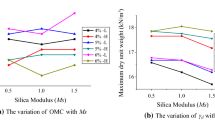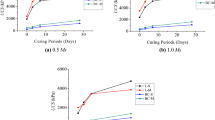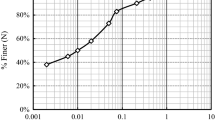Abstract
The natural aggregates are depleting in developing countries due to the excessive usage in road and building construction. In the present study, the engineering properties of abundantly available lateritic soil stabilized with Ground Granulated Blast Furnace Slag (GGBS) and alkali solutions like Sodium hydroxide and Sodium silicate was evaluated. The suitability of stabilized soil as a base course in flexible pavements was investigated. The lateritic soil was treated with 15, 20, 25 and 30% of GGBS and alkali solutions consisting of 5% of Sodium oxide with Silica Modulus (Ms) of 0.5, 1.0 and 1.5 at a constant water binder ratio of 0.25. The improved unconfined compressive strength, flexural strength, and fatigue life were observed from the soil treated with 30% of GGBS and alkali solution having Ms 1.0 air-cured for 28 days at ambient temperature. The improvement is due to the formation of Calcium Silicate Hydrates and Calcium Alumino Silicate Hydrates from an exothermic reaction between Calcium ions and the dissolved silicates and aluminates present in GGBS and alkali solutions. The samples treated with 25, 30% of GGBS and alkali solution having 1.0 Ms cured for 28 days found to be durable in Wetting-Drying and Freezing-Thawing tests. The compact and densified crystal orientation of the treated soil samples was observed from the microstructure images obtained from the Scanning Electron Microscope technique. The design of low and high volume roads was suggested with stabilized soil and strains developed at different locations on the proposed pavement were analyzed using pavement analysis software.
Similar content being viewed by others
References
M Gidigasu, Laterite Soil Engineering: Pedogenesis and Engineering Principles, 1976.
S.N. Eluozo, C. Nwaobakata, Predictive models to determine the behavior of plastic and liquid limit of Lateratic soil for Raod construction at Egbema: Imo state of Nigeria, Int. J. Eng. Technol. 2 (1) (2012) 25. https://doi.org/10.14419/ijet.v2i1.425.
E. Mengue, H. Mroueh, L. Lancelot, R.M. Eko, Mechanical improvement of a fine-grained lateritic soil treated with cement for use in road construction, J. Mater. Civ. Eng. 29 (11) (2017) 1–22. https://doi.org/10.1061/(ASCE)MT.1943-5533.0002059.
I.T. Jawad, M.R. Taha, Z.H. Majeed, T.A. Khan, Soil stabilization using lime: Advantages, disadvantages and proposing a potential alternative, Res. J. Appl. Sci. Eng. Technol. 8 (4) (2014) 510–520.
A. Hooshmand, M.H. Aminfar, E. Asghari, H. Ahmadi, Mechanical and Physical Characterization of Tabriz Marls, Iran, Geotech. Geol. Eng. 30 (2012) 219–232. https://doi.org/10.1007/s10706-011-9464-3.
J. Khazaei, H. Moayedi, Soft Expansive Soil Improvement by Eco-Friendly Waste and Quick Lime, Arab. J. Sci. Eng. 44 (2019) 8337–8346. https://doi.org/10.1007/s13369-017-2590-3.
M. Joel, I.O. Agbede, Mechanical-cement stabilization of laterite for use as flexible pavement material, J. Mater. Civ. Eng. 23 (2) (2011) 146–152. https://doi.org/10.1061/(ASCE)MT.1943-5533.0000148.
A.U.R. Shankar, H.K. Rai, R.I. Mithanthaya, Bio-Enzyme stabilised laterite soil as a highway material, J. Indian Roads Congr. Pap. No. 553. (2009) 143–151.
E. Coudert, M. Paris, D. Deneele, G. Russo, A. Tarantino, Use of alkali activated high-calcium fly ash binder for kaolin clay soil stabilisation: Physicochemical evolution, Constr. Build. Mater. 201 (2019) 539–552. https://doi.org/10.1016/j.conbuildmat.2018.12.188.
N. Latifi, F. Vahedifard, E. Ghazanfari, S. Horpibulsuk, A. Marto, J. Williams, Sustainable improvement of clays using low-carbon nontraditional additive, Int. J. Geomech. 18 (3) (2018). https://doi.org/10.1061/(ASCE)GM.1943-5622.0001086.
M.H. Fasihnikoutalab, A. Asadi, B.K. Huat, R.J. Ball, S. Pourakbar, P. Singh, Utilisation of carbonating olivine for sustainable soil stabilization, Environ. Geotech. 4 (2017) 184–198. https://doi.org/10.1680/jenge.15.00018.
M.H. Fasihnikoutalab, A. Asadi, B. Kim Huat, P. Westgate, R.J. Ball, S. Pourakbar, Laboratory-scale model of carbon dioxide deposition for soil stabilisation, J. Rock Mech. Geotech. Eng. 8 (2) (2016) 178–186. https://doi.org/10.1016/j.jrmge.2015.11.001.
H. Bahadori, A. Hasheminezhad, F. Taghizadeh, Experimental study on marl soil stabilization using natural pozzolans, J. Mater. Civ. Eng. 31 (2) (2019) 1–10. https://doi.org/10.1061/(ASCE)MT.1943-5533.0002577.
H. Bahadori, A. Hasheminezhad, S. Mohamadi asl, Stabilisation of Urmia Lake peat using natural and artificial pozzolans, Proc. Inst. Civ. Eng. — Gr. Improv. (2019) 1–10. https://doi.org/10.1680/jgrim.19.00024.
H. Bahadori, A. Hasheminezhad, S. Alizadeh, The Influence of Natural Pozzolans Structure on Marl Soil Stabilization, Transp. Infrastruct. Geotechnol. 7 (2019) 46–54. https://doi.org/10.1007/s40515-019-00089-4.
S.N. Kane, A. Mishra, A.K. Dutta, Preface: International Conference on Recent Trends in Physics (ICRTP 2016), J. Phys. Conf. Ser. 755 (2016) 1–7. https://doi.org/10.1088/1742-6596/755/1/011001.
M.H. Fasihnikoutalab, P. Westgate, B.B.K. Huat, A. Asadi, R.J. Ball, H. Nahazanan, P. Singh, New insights into potential capacity of olivine in ground improvement, Electron. J. Geotech. Eng. 20 (2015) 2137–2148.
S. V Patankar, S.S. Jamkar, Y.M. Ghugal, Effect of Water-To-Geopolymer Binder Ratio on the Production of Fly Ash Based Geopolymer Concrete, Int. J. Adv. Technol. Civ. Eng. 2 (1) (2013) 79–83. https://doi.org/10.13140/2.1.4792.1284.
H. Dehghan, A. Tabarsa, N. Latifi, Y. Bagheri, Use of xanthan and guar gums in soil strengthening, Clean Technol. Environ. Policy. 21 (2019) 155–165. https://doi.org/10.1007/s10098-018-1625-0.
A. Allahverdi, E. Najafi Kani, S. Esmaeilpoor, Effects of Silica Modulus and Alkali Concentration on Activation of Blast-Furnace Slag, Iran. J. Mater. Sci. Eng. 5 (2008) 32–35. http://ijmse.iust.ac.ir/browse.php?a_code=A-10-3-26&slc_lang=en&sid=1.
M.N. Qureshi, S. Ghosh, Effect of Alkali Content on Strength and Microstructure of GGBFS Paste, Glob. J. Res. Eng. Civ. Struct. Eng. 13 (2013) 11–20.
G.N. Obuzor, J.M. Kinuthia, R.B. Robinson, Soil stabilisation with lime-activated-GGBS-A mitigation to flooding effects on road structural layers/embankments constructed on floodplains, Eng. Geol. 151 (2012) 112–119. https://doi.org/10.1016/j.enggeo.2012.09.010.
O.S. Olaniyan, R. A. Olaoye, O.M. Okeyinka, D.B. Olaniyan, Soil stabilization techniques using sodium hydroxide additives, Int. J. Civ. 11 (6) (2011) 9–22. http://www.ijens.org/vol_11_i_06/111003-06-8484-ijceeijens.pdf.
Fasihnikoutalab, M.H., Pourakbar, S., Ball, R.J. et al. Sustainable soil stabilisation with ground granulated blast-furnace slag activated by olivine and sodium hydroxide. Acta Geotech. (2019). https://doi.org/10.1007/s11440-019-00884-w.
N. Mane, P.M.S. Rajashekhar, R. Mud, Stabilization of Black Cotton Soil by Using Red Mud and Sodium Silicate, Int. Res. J. Eng. Technol. 4 (2017) 2929–2932. https://irjet.net/archives/V4/i7/IRJET-V4I7591.pdf.
Hossein Moayedi, Stabilization of organic soil using sodium silicate system grout, Int. J. Phys. Sci. 7 (9) (2012) 1395–1402. https://doi.org/10.5897/ijps11.1509.
A. Stempkowska, J. Mastalska-Poplawska, P. Izak, L. Oglaza, M. Turkowska, Stabilization of kaolin clay slurry with sodium silicate of different silicate moduli, Appl. Clay Sci. 146 (9) (2017) 147–151. https://doi.org/10.1016/j.clay.2017.05.046.
M.H. Fasihnikoutalab, S. Pourakbar, R.J. Ball, B.K. Huat, The Effect of Olivine Content and Curing Time on the Strength of Treated Soil in Presence of Potassium Hydroxide, Int. J. Geosynth. Gr. Eng. 3 (12) (2017) 0. https://doi.org/10.1007/s40891-017-0089-3.
N. Latifi, F. Vahedifard, E. Ghazanfari, A.S.A. Rashid, Sustainable usage of calcium carbide residue for stabilization of clays, J. Mater. Civ. Eng. 30 (6) (2018). https://doi.org/10.1061/(ASCE)MT.1943-5533.0002313.
J.C. Petermann, A. Saeed, Alkali-Activated Geopolymers: a Literature Review, Air Force Res. Lab. (2012) 1–99.
A. Thomas, R.K. Tripathi, L.K. Yadu, A Laboratory Investigation of Soil Stabilization Using Enzyme and Alkali-Activated Ground Granulated Blast-Furnace Slag, Arab. J. Sci. Eng. 43 (2018) 5193–5202. https://doi.org/10.1007/s13369-017-3033-x.
P. Ghadir, N. Ranjbar, Clayey soil stabilization using geopolymer and Portland cement, Constr. Build. Mater. 188 (2018) 361–371. https://doi.org/10.1016/j.conbuildmat.2018.07.207.
M.M. Yadollahi, A. Benli, R. Demirbota, The effects of silica modulus and aging on compressive strength of pumice-based geopolymer composites, Constr. Build. Mater. 94 (2015) 767–774. https://doi.org/10.1016/j.conbuildmat.2015.07.052.
J.C. Petermann, A. Saeed, M.I. Hammons, Alkali-Activated Geopolymers: aLiterature Review Air Force Research Laboratory Materials and Manufacturing Directorate, Air Force Materiel Command, United States Air Force, Tyndall Air Force Base, FL 32403–5323, 2010.
M.H. Fasihnikoutalab, A. Asadi, C. Unluer, B.K. Huat, R.J. Ball, S. Pourakbar, Utilization of alkali-activated olivine in soil stabilization and the effect of carbonation on unconfined compressive strength and microstructure, J. Mater. Civ. Eng. 29 (6) (2017) 1–11. https://doi.org/10.1061/(ASCE)MT.1943-5533.0001833.
G.N. Obuzor, J.M. Kinuthia, R.B. Robinson, Enhancing the durability of flooded low-capacity soils by utilizing lime-activated ground granulated blastfurnace slag (GGBS), Eng. Geol. 123 (3) (2011) 179–186. https://doi.org/10.1016/j.enggeo.2011.07.009.
E. Coudert, M. Paris, D. Deneele, G. Russo, A. Tarantino, Use of alkali activated high-calcium fly ash binder for kaolin clay soil stabilisation: Physicochemical evolution, Constr. Build. Mater. 201 (2019) 539–552. https://doi.org/10.1016/j.conbuildmat.2018.12.188.
B.M. Lekha, G. Sarang, A.U.R. Shankar, Effect of Electrolyte Lignin and Fly Ash in Stabilizing Black Cotton Soil, Transp. Infrastruct. Geotechnol. 2 (2015) 87–101. https://doi.org/10.1007/s40515-015-0020-0.
B.M. Lekha, S. Goutham, A.U.R. Shankar, Evaluation of lateritic soil stabilized with Arecanut coir for low volume pavements, Transp. Geotech. 2 (2015) 20–29. https://doi.org/10.1016/j.trgeo.2014.09.001.
S. Amulya, A.U. Ravi Shankar, M. Praveen, Stabilisation of lithomargic clay using alkali activated fly ash and ground granulated blast furnace slag, Int. J. Pavement Eng. 0 (2018) 1–8. https://doi.org/10.1080/10298436.2018.1521520.
Nabil, M., Mustapha, A. & Rios, S. Impact of wetting—drying cycles on the mechanical properties of lime-stabilized soils. Int. J. Pavement Res. Technol. 13 (1) (2020) 83–92. https://doi.org/10.1007/s42947-019-0088-y.
M. Chi, Effects of modulus ratio and dosage of alkali-activated solution on the properties and micro-structural characteristics of alkali-activated fly ash mortars, Constr. Build. Mater. 99 (2015) 128–136. https://doi.org/10.1016/j.conbuildmat.2015.09.029.
N. Hassan, W.H. Wan Hassan, A.S.A. Rashid, N. Latifi, N.Z. Mohd Yunus, S. Horpibulsuk, H. Moayedi, Microstructural characteristics of organic soils treated with biomass silica stabilizer, Environ. Earth Sci. 78 (2019) 1–9. https://doi.org/10.1007/s12665-019-8369-y.
T. Phoo-Ngernkham, A. Maegawa, N. Mishima, S. Hatanaka, P. Chindaprasirt, Effects of sodium hydroxide and sodium silicate solutions on compressive and shear bond strengths of FA-GBFS geopolymer, Constr. Build. Mater. 91 (2015) 1–8. https://doi.org/10.1016/j.conbuildmat.2015.05.001.
R. Firdous, D. Stephan, Effect of silica modulus on the geopolymerization activity of natural pozzolans, Constr. Build. Mater. 219 (2019) 31–43. https://doi.org/10.1016/j.conbuildmat.2019.05.161.
Y. Yi, C. Li, S. Liu, Alkali-activated ground-granulated blast furnace slag for stabilization of marine soft clay, J. Mater. Civ. Eng. 27 (2015) 1–7. https://doi.org/10.1061/(ASCE)MT.1943-5533.0001100./
Acknowledgments
The authors acknowledge the National Institute of Technology Karnataka, Surathkal for supporting this work by providing required help.
Author information
Authors and Affiliations
Corresponding author
Additional information
Peer review under responsibility of Chinese Society of Pavement Engineering.
Rights and permissions
About this article
Cite this article
Shivaramaiah, A., Ravi Shankar, A.U., Singh, A. et al. Utilization of lateritic soil stabilized with alkali solution and ground granulated blast furnace slag as a base course in flexible pavement construction. Int. J. Pavement Res. Technol. 13, 478–488 (2020). https://doi.org/10.1007/s42947-020-0251-5
Received:
Revised:
Accepted:
Published:
Issue Date:
DOI: https://doi.org/10.1007/s42947-020-0251-5




